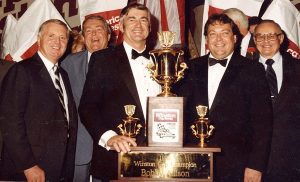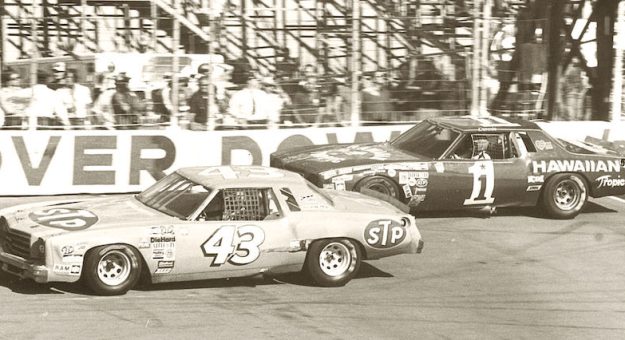Some of the closest and most memorable championship battles in NASCAR history have come since 1971, the beginning of what is known as the sport’s modern era.
1973
One of those came in the final race of the 1973 Cup Series season. That year, the points system was based on a complicated formula involving the length of the race and the number of laps completed. Benny Parsons, driving for car owner L.G. Dewitt, entered the 492-lap race at Rockingham (N.C.) Speedway set to cruise to the title.

However, after being involved in a six-car crash on lap 13, crew members from several teams came together and literally rebuilt Parsons’ badly damaged ride. The work included transplanting part of the roll cage and door-bar structure from a car that failed to qualify for the race.
As a result, Parsons returned to the track, completed 308 laps, finished 28th and earned the prestigious NASCAR Cup Series championship. He ended up beating Cale Yarborough by 67 points
“There have been several times in my life that I’ve thought the best thing I could do was walk away from a racing career,” Parsons said in the 1973 edition of the Winston Yearbook. “Those moments have come at almost every level on my way to NASCAR Winston Cup racing, but for some reason, I could never quit. In my mind, I would have been a loser or a quitter if I had given up and not given racing that final, all-out, last-gasp chance to see if I could be successful.”
1979
Entering the final race of 1979 Cup Series season at California’s Ontario Motor Speedway, Richard Petty, driving the No. 43 Petty Enterprises Chevrolet, trailed Darrell Waltrip and his DiGard Racing operation by two points.
On the 38th of 200 laps, Waltrip spun to avoid a crash involving John Rezek. The incident left the Owensboro, Ky., driver a lap down, and he could never make up the lost ground. Waltrip settled for eighth, while Petty took the checkered flag fifth and claimed his seventh series crown by 11 points.
“In 1979, we were way behind in points to Darrell Waltrip and the DiGard team he was driving for with five or six races to go,” Petty said. “We just went ahead and ran our races and concentrated on that more than worrying about what Darrell was doing. I think Darrell lost it more than anything because he got to watching us and what we were doing more than concentrating on his racing. We didn’t worry about him. We just went out and raced as hard as we could and took what we could get.”
Understandably, Waltrip was quite dejected.
“It’s hard to swallow,” Waltrip said, as documented in Greg Fielden’s “40 Years of Stock Car Racing.” “I ain’t never going to figure it out. Never, never, never. I came here with all of my hopes and I’m leaving here with a broken heart. It’s very depressing, very depressing.”
1981-’83
Bobby Allison and Darrell Waltrip were the championship combatants during the 1981, ’82 and ’83 seasons.
Driving for Harry Ranier in 1981 and DiGard Racing in 1982 and ’83, Allison and his rival engaged in some fierce on-track and verbal confrontations during the period.
Waltrip, wheeling the No. 11 Chevrolet for Junior Johnson, claimed the championship trophy in 1981 by 53 points and by 72 points in ’82. Allison was victorious over Waltrip for NASCAR’s coveted crown in 1983 by only 26 points.
“We had some incredible championship runs in those years,” Allison said. “It seemed like there were times we would have a win and gain the advantage and then we’d lose it because we would crash or have a mechanical problem. We fell short on wins and points in 1981 with Harry’s team, and then again with DiGard Racing in 1982. We worked extremely hard to beat Darrell and Junior those years. What a heartbreak that was both of those years. Winning it in 1983 was truly the thrill of my life.”
Jeff Hammond, Waltrip’s crew chief at the time, recalls the intensity of the period.
“Winning those championships in 1981 and ’82 was like a dream that came true,” Hammond said. “The team just embracing what they had accomplished and enjoying the fact the pressure valve had been released, and we had accomplished what we set out to do.”
